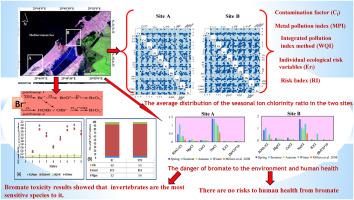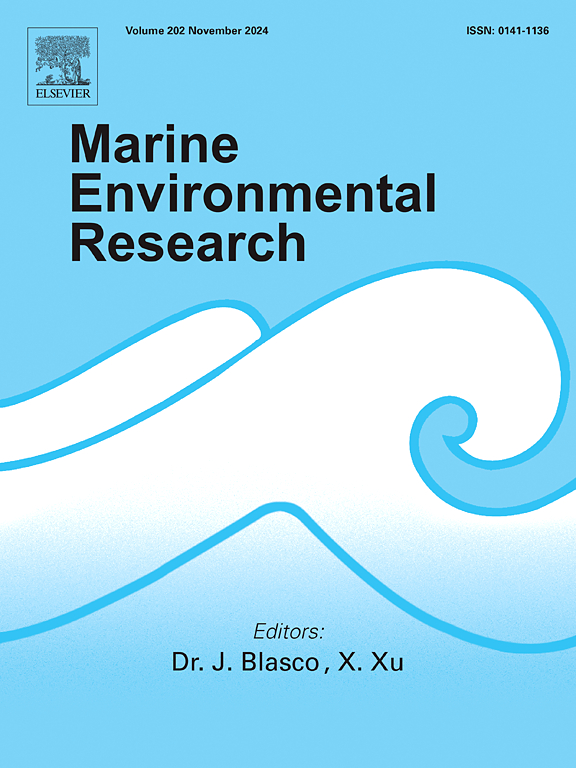Ecotoxicity of bromate and human health risks resulting from wastewater treatment units' effluents associated with some key physicochemical parameters in two hotspots connected to the Egyptian Mediterranean Sea
IF 3
3区 环境科学与生态学
Q2 ENVIRONMENTAL SCIENCES
引用次数: 0
Abstract
This study is the first of its kind in terms of focusing on the seasonal monitoring of bromine species (bromide− and bromate) and some of the main physicochemical parameters in the surface water of stations inside and in front of the El Noubareya and El-Umum drains that flow directly or indirectly to the Egyptian Mediterranean coast at A (El Noubareya Drain) and B (El-Mex Bay) sites. Among the bromine species, bromate (BrO3−) is a disinfection byproduct considered by many international agencies to have a potential carcinogenic effect in humans and is also known to be ecologically toxic to aquatic organisms. Drain water samples collected from the studied sites A and B had a bromide/chlorinity ratio (3.85E-03 - 6.25E-03 and 3.27E-03 - 6.97E-03, respectively) significantly higher than the typical value for open seawater (3.50E-03), showing significant dilution with wastewater at drain stations in the investigated sites. The source and origin of bromine species and the major ions studied associated with the wastewater units were identified and tracked by calculating the ion/chlorinity ratio and multivariate analysis. The total hazard quotient (THQ) for bromate intake and dermal exposure in children, females, and males demonstrates negligible harm to human health. The toxic unit (TU) and the sum of toxic units (STU) values of the three trophic levels in the surface water for the two sites under investigation yielded approximately comparable values for risk quotient (RQ) and mixture risk characterization ratios (RCRmix(MEC/PNEC)), indicating that invertebrates are more sensitive to bromate dangers than fish and algae. The study highlights the importance of conducting large-scale laboratory tests on the effluents resulting from wastewater treatment units, including bromide levels, to prevent the formation of dangerous side compounds such as bromate, which may have negative effects on populations and may lead to the toxicity of trophic levels in ecosystems.

在与埃及地中海相连的两个热点地区,与一些关键理化参数相关的废水处理装置排出的溴酸盐的生态毒性和人类健康风险。
这项研究是首次对直接或间接流向埃及地中海沿岸的 El Noubareya 和 El-Umum 排水渠 A(El Noubareya 排水渠)和 B(El-Mex 海湾)站点内和站点前的地表水中的溴物种(溴化物和溴酸盐)和一些主要物理化学参数进行季节性监测。在溴的种类中,溴酸盐(BrO3-)是一种消毒副产品,许多国际机构认为它对人类有潜在的致癌作用,而且已知它对水生生物具有生态毒性。从研究地点 A 和 B 采集的排水样本的溴/氯比值(分别为 3.85E-03 - 6.25E-03 和 3.27E-03 - 6.97E-03)明显高于开放式海水的典型值(3.50E-03),表明调查地点排水站的排水样本被废水严重稀释。通过计算离子/氯度比值和多元分析,确定并追踪了与废水单元相关的溴物种和主要离子的来源和出处。儿童、女性和男性摄入和皮肤接触溴酸盐的总危害商数(THQ)表明,对人体健康的危害可以忽略不计。调查的两个地点地表水中三个营养级的毒性单位(TU)和毒性单位总和(STU)值得出了大致相当的风险商数(RQ)和混合物风险特征比(RCRmix(MEC/PNEC))值,表明无脊椎动物比鱼类和藻类对溴酸盐危害更敏感。这项研究强调了对废水处理装置产生的污水(包括溴化物含量)进行大规模实验室检测的重要性,以防止形成溴酸盐等危险的副化合物,这些副化合物可能会对种群产生负面影响,并可能导致生态系统中营养级的毒性。
本文章由计算机程序翻译,如有差异,请以英文原文为准。
求助全文
约1分钟内获得全文
求助全文
来源期刊

Marine environmental research
环境科学-毒理学
CiteScore
5.90
自引率
3.00%
发文量
217
审稿时长
46 days
期刊介绍:
Marine Environmental Research publishes original research papers on chemical, physical, and biological interactions in the oceans and coastal waters. The journal serves as a forum for new information on biology, chemistry, and toxicology and syntheses that advance understanding of marine environmental processes.
Submission of multidisciplinary studies is encouraged. Studies that utilize experimental approaches to clarify the roles of anthropogenic and natural causes of changes in marine ecosystems are especially welcome, as are those studies that represent new developments of a theoretical or conceptual aspect of marine science. All papers published in this journal are reviewed by qualified peers prior to acceptance and publication. Examples of topics considered to be appropriate for the journal include, but are not limited to, the following:
– The extent, persistence, and consequences of change and the recovery from such change in natural marine systems
– The biochemical, physiological, and ecological consequences of contaminants to marine organisms and ecosystems
– The biogeochemistry of naturally occurring and anthropogenic substances
– Models that describe and predict the above processes
– Monitoring studies, to the extent that their results provide new information on functional processes
– Methodological papers describing improved quantitative techniques for the marine sciences.
 求助内容:
求助内容: 应助结果提醒方式:
应助结果提醒方式:


